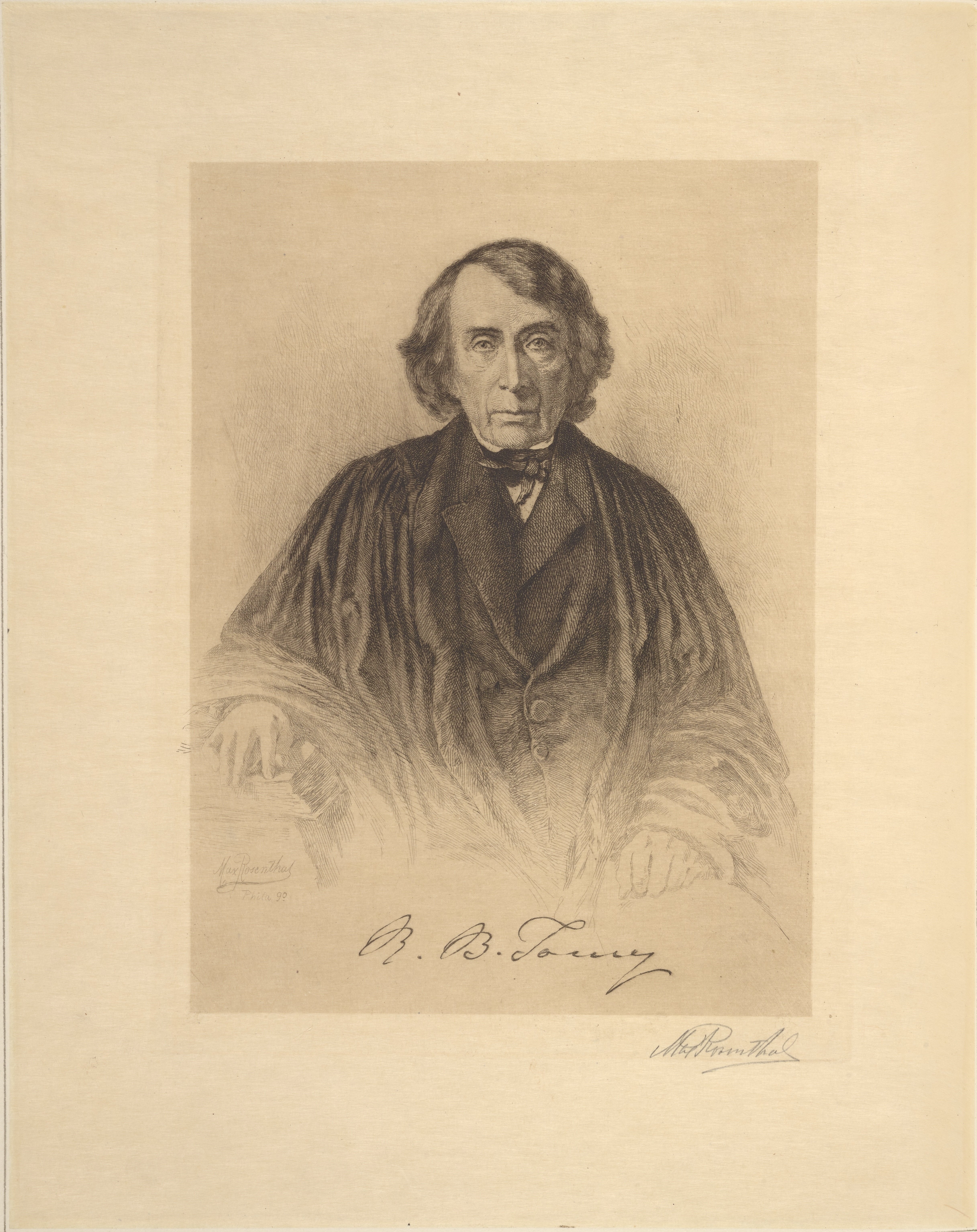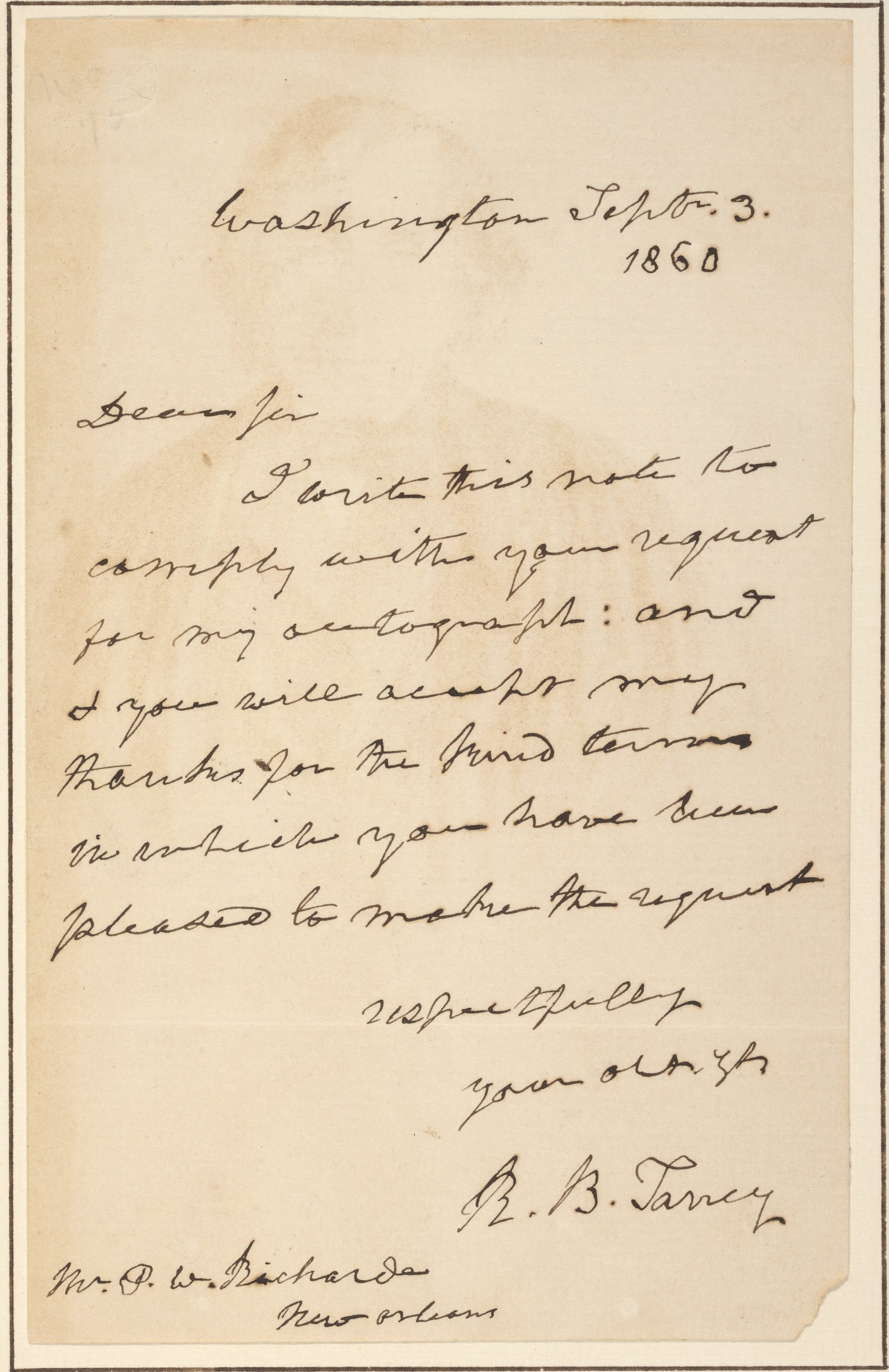Roger Brooke Taney
Roger Brooke Taney (1777-1864) served as the Chief Justice of the United States Supreme Court from 1836 to 1864.
Portrait
Max Rosenthal, R. B. Taney, 1890, print: etching, United States Supreme Court: Portraits and Autographs, D'Angelo Law Library Rare Book Room, University of Chicago Library.
Signed by the artist, Max Rosenthal.
For more information about the etched portrait of Roger Brooke Taney, see:
- "Robert B. Taney, 1777-1864," Record, Prints & Photographs Online Catalog, Prints & Photographs Reading Room, Library of Congress, accessed July 2, 2019, https://www.loc.gov/pictures/item/89707858/.
Signature
Detail from Roger Brooke Taney to P. W. Richards, 3 September 1860, United States Supreme Court: Portraits and Autographs, D'Angelo Law Library Rare Book Room, University of Chicago Library.
The Document
Roger Brooke Taney to P. W. Richards, 3 September 1860, United States Supreme Court: Portraits and Autographs, D'Angelo Law Library Rare Book Room, University of Chicago Library.
Transcription of the Letter:
Washington Sept. 3. 1860
Dear Sir
I write this note to comply with your request for my autograph: and if you will accept my thanks for the kind terms in which you have [been] pleased to make the request.
Respectfully
Your obt. svt.
R. B. Taney
Mr. P. W. Richards
New Orleans
About this Document
About the Taney Court and the Dred Scott Case
At the time that he sent this letter, Roger Brooke Taney was serving as Chief Justice of the U.S. Supreme Court. The Court had recently entered the national debate about slavery with its 1857 decision in the case Dred Scott v. Sandford, 60 U.S. 393 (1857). Chief Justice Taney's majority opinion in that case, which held (in part) that people of African descent were not and could not be considered citizens under the U.S. Constitution, caused a national uproar and gained him both censure and applause from the American public. Shortly after the case was decided, one of the dissenting Justices on that case, Justice Benjamin Robbins Curtis, resigned from the Court.
For more about the Taney Court and the Dred Scott Case, see:
- R. Kent Newmyer, The Supreme Court under Marshall and Taney (Wheeling, IL: Harlan Davidson, Inc., 2006).
- Timothy S. Huebner, The Taney Court: Justices, Rulings, and Legacy (Santa Barbara, CA: ABC-CLIO, 2003).
- Follow this link to search the University of Chicago Library catalog for the subject heading "Scott, Dred, 1809-1858".
- "Dred Scott v. Sandford," Primary Documents of American History, Virtual Programs & Services, Library of Congress, accessed July 16, 2019, https://www.loc.gov/rr/program/bib/ourdocs/dredscott.html.
- Contains links to documents in the Library of Congress collections as well as links to external resources and a selected bibliography.
- "The Revised Dred Scott Case Collection," Digital Gateway, Washington University, accessed July 16, 2019, http://digital.wustl.edu/d/dre/index.html.
About the Election of 1860 and the Impending Civil War
This letter was sent just two months before the 1860 election, in which Abraham Lincoln was elected President of the United States. By the time President Lincoln took office in March of 1861, seven states, including Louisiana (where the recipient of this letter from Chief Justice Taney lived), had declared their secession from the United States.
For more about the Election of 1860 and the Impending Civil War, see:
- Follow this link to search the University of Chicago Library catalog for the subject heading "Presidents -- United States -- Election -- 1860".
- "Presidential Election of 1860: A Resource Guide," Web Guides, Virtual Programs & Services, Library of Congress, accessed July 17, 2019, https://www.loc.gov/rr/program/bib/elections/election1860.html.
- "Civil War," Military Records, Research, National Archives and Records Administration, accessed July 17, 2019, https://www.archives.gov/research/military/civil-war.
About Roger Brooke Taney
Roger Brooke Taney began his career in Maryland, participating in politics, the private practice of law, and banking. After serving briefly as the Maryland Attorney General, he was nominated to serve as acting Secretary of War by President Andrew Jackson in 1831 after all but one of Jackson's cabinet members resigned. He established himself as a political ally to Jackson, who then named him Attorney General. As Attorney General, he argued that the national bank (the Second Bank of the United States) was unconstitutional, and during his brief service as Jackson's acting Secretary of the Treasury drained the bank of federal funds and transferred the funds to state banks. Taney's nomination as Secretary of the Treasury was rejected in 1834, the first time the Senate rejected the nomination of a cabinet member.
Taney was then nominated to the Supreme Court by Jackson in 1835, but the Senate did not vote to confirm the nomination. After John Marshall's death later that year, Jackson again nominated Taney to the Court, this time as Chief Justice, and the nomination was confirmed in 1836. Taney served as Chief Justice until his death in 1864.
For more about Roger Brooke Taney's life and career, see:
- Follow this link to search the University of Chicago Library catalog for the subject heading "Taney, Roger Brooke, 1777-1864".
- "Taney, Roger Brooke," Federal Judicial Center, accessed July 16, 2019, https://www.fjc.gov/history/judges/taney-roger-brooke.
- Lists background information on his professional career as well as a bibliography and list of manuscript collections.
- "Roger B. Taney (1833-1834)," U. S. Department of the Treasury, accessed July 16, 2019, https://www.treasury.gov/about/history/pages/rbtaney.aspx.
- "The Papers of Roger B. Taney, 1792 (1805-1812) - 1818," Special Collections, Arthur J. Morris Law Library, University of Virginia Law School, accessed July 16, 2019, http://archives.law.virginia.edu/records/mss/87-3.
- "Roger Brooke Taney legal papers," Archives and Special Collections, Dickinson College, accessed July 16, 2019, http://archives.dickinson.edu/collection-descriptions/roger-brooke-taney-legal-papers.



